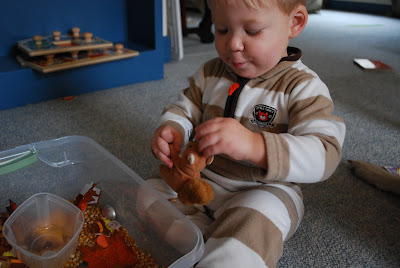This month's sensory box includes popcorn kernels as a base. I have silk leaves, plastic acorns, scarecrow and pilgrim faces, foam pumpkins, and a stuffed squirrel and turkey. There are measuring spoons and a bowl as well.
I introduce the box by letting Jacob explore on his own for a few minutes. Then I start pointing out different items in the box. I show him what he can do with them and I model observing each item to learn more about them.
My goals for this sensory box are:
1. Practice fine motor skills by scooping popcorn kernels with spoons
2. Imaginary play by pretending to feed squirrel acorns
3. Identify facial features and 'hats' on scarecrow and pilgrim faces
(He is pointing to his own mouth instead of the one on the pilgrim)
4. Free play and Having Fun!







Comments
Post a Comment